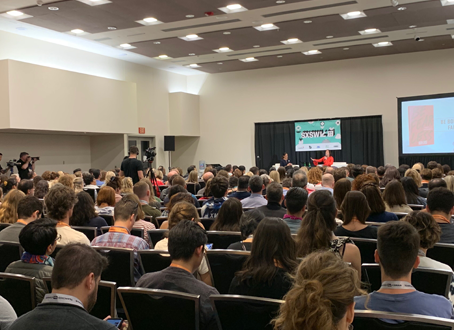We have long been enthusiastic champions of democratizing philanthropy at the Case Foundation. In the same way that technology has leveled the playing field to allow all voices to be heard, we believe technology has proven its potential to empower anyone to become a philanthropist. Indeed, as the nation sets its sights on another #GivingTuesday, it is important to remember that online giving was just a nascent movement not that long ago.
Our early work in experimentation with social media platforms included America’s Giving Challenge (AGC), dating back to nearly a decade ago. At the time, we were concerned that both donors and nonprofits weren’t fully prepared for the potential of the brand new world of social media, and we knew we needed a bold step to move people toward the online tools we knew could transform the future of online giving.
AGC called on citizens everywhere to use emerging social media platforms to get engaged and give to causes they cared about. Incentives were established to encourage the greatest number of donations, not necessarily the largest, and donations of all sizes were welcomed. As part of the campaign, our “Gear Up for Giving” helped train thousands of individuals and nonprofits so that they could best leverage social media to reach their networks. We also invited people everywhere to be champions for their own causes, instead of curating a list that were our favorites.
Back then, online philanthropic competitions of this kind were relatively unheard of, and I’ll admit that we weren’t sure what to expect at first. There were so many unknowns. Would the big organizations dwarf the little guys? How would social media be activated to spread the word and reach new audiences? Would organizations be nimble enough to effectively mobilize their networks? To our surprise it was the small organizations that had the most success, and taken together, microdonations from across the nation represented significant sums for the winning causes.
Along with partners like Causes on Facebook, PARADE Magazine, Network for Good, and GlobalGiving, over the course of these two Giving Challenges we were able to mobilize nearly 200,000 people and nearly $4 million was raised for thousands of causes. Both Challenges were effective in helping the nonprofit sector become more skilled in its use of social media and they inspired other corporations and foundations to launch similar online contests. Following this work, the Case Foundation published findings and lessons learned, and worked closely with follow-on campaigns such as the Pepsi Challenge and days of giving that were popping up across the nation.
Ever since those early pioneering efforts, we have remained captivated by the idea that emerging technologies and tools can be leveraged to democratize philanthropy and provide new significance to the individual donor.
Over the years, both through the Case Foundation and through individual investments, we have encouraged “good” giving and have supported different ways to leverage technology to drive a social mission—including the very first DC Give to the Max Day, Causes on Facebook, Network for Good and MissionFish. Combined, Causes, Network for Good, and MissionFish alone represent more than $2 billion in crowdsourced contributions to the nonprofit sector.
These early online platforms and technologies provided a new way to increase opportunities to give by uniting people around causes that were close to their hearts and deepening their civic engagement. This was game-changing and has led to many innovations that have changed the way we give and give back.
In a few short years, online platforms like Network for Good, Crowdrise, Indiegogo, Razoo, Classy, and GlobalGiving have gained in popularity and have been instrumental in raising billions of dollars. Through these platforms and others like them, individuals could fund all kinds of inspiring causes and needs and, perhaps most importantly, catalyze civic action one donor at a time.
This is why we were intrigued to answer the question, “what’s next in online giving?”
At its Social Good Forum just a couple weeks ago, Facebook announced that users can now build their own fundraising pages that link the donate button to Facebook Live videos. Imagine being able to show, via live stream, your support for a cause while viewers donate in real time. The possibilities seem almost limitless. What’s nearly as exciting to us is that Facebook collaborated with our longstanding partner, Network for Good, to make this happen. It stands to reason that we will soon see fundraising on other social media platforms like Snapchat, which recently introduced Snapcash, and Twitter, which already allows for direct payments using $Cashtags.
And there may be no better example of the growing and transformative power of social media and the spirit of collaboration in philanthropy than #GivingTuesday. In 2015 alone 698,961 online donors raised $116.7m on #GivingTuesday, and #GivingTuesday continues to grow in size with a 52 percent year-over-year increase in online donations.
We’ve had the pleasure of being involved with #GivingTuesday from when it was just a concept being formulated by our friends at 92 Street Y and the United Nations Foundation. Since its inaugural year in 2012, we have been vocal supporters of the #GivingTuesday movement because it reflects our long-held belief in the importance of collective action.
While many look towards foundations, corporations and the government for resources, they often forget that 72 percent of giving in this country comes from individuals—and, if we’re ever going to see tipping points in addressing chronic and significant social problems it will require mobilization of the masses.
The good news is that online giving grew 9.2 percent in 2015 compared to 2014—we are seeing growing momentum in the mobilization of online donors. But I believe we have only scratched the surface. Just 7.1 percent of overall fundraising dollars are raised online. And when looking at the next generation of 80 million Millennials, we know that they primarily use digital technology such as websites, social media and mobile platforms to access information about and donate to causes and nonprofits, and that each platform plays a distinct role. And while giving offline will likely remain an important way to give for some time to come, we also must continue to leverage new technologies and data to make the process of giving even more convenient and rewarding.
If the past is any indication, we have an extraordinary opportunity ahead of us to further connect the passion of individuals ready to make a difference with new platforms, technologies and innovations that can help them do just that. This #GivingTuesday, each and every one of us has the opportunity to donate to the causes that matter most to us. Our hope is that the democratization of giving will be further strengthened in the days ahead and our communities made stronger as a result.





